Cybersecurity: Analyzing Trust, Social Engineering, and Legal Issues
VerifiedAdded on 2022/09/09
|6
|1447
|17
Homework Assignment
AI Summary
This assignment delves into various aspects of cybersecurity, starting with strategies to improve customer trust in e-commerce, such as website viability, detailed product information, empathy, and originality. It addresses the risks associated with email attacks, including phishing and spoofing, and provides preventative measures against social engineering, such as deleting suspicious requests, rejecting unsolicited help, and enhancing device security. The discussion extends to the economic factors influencing cybersecurity, highlighting the importance of data protection in economic sectors and the barriers to improvement, like lack of investment and overlooked privacy policies. Furthermore, the assignment examines the effectiveness of legal measures in protecting cybersecurity, acknowledging their limitations due to the vast flow of online information and the overlooking of privacy policies. It differentiates between law and ethics, emphasizing their roles in governing behavior and guiding moral conduct, respectively. Finally, it reflects on the journey through the course topics, emphasizing the evolution of cybersecurity strategies to protect individuals, organizations, and society as a whole, and the application of economic principles to address cybersecurity challenges.
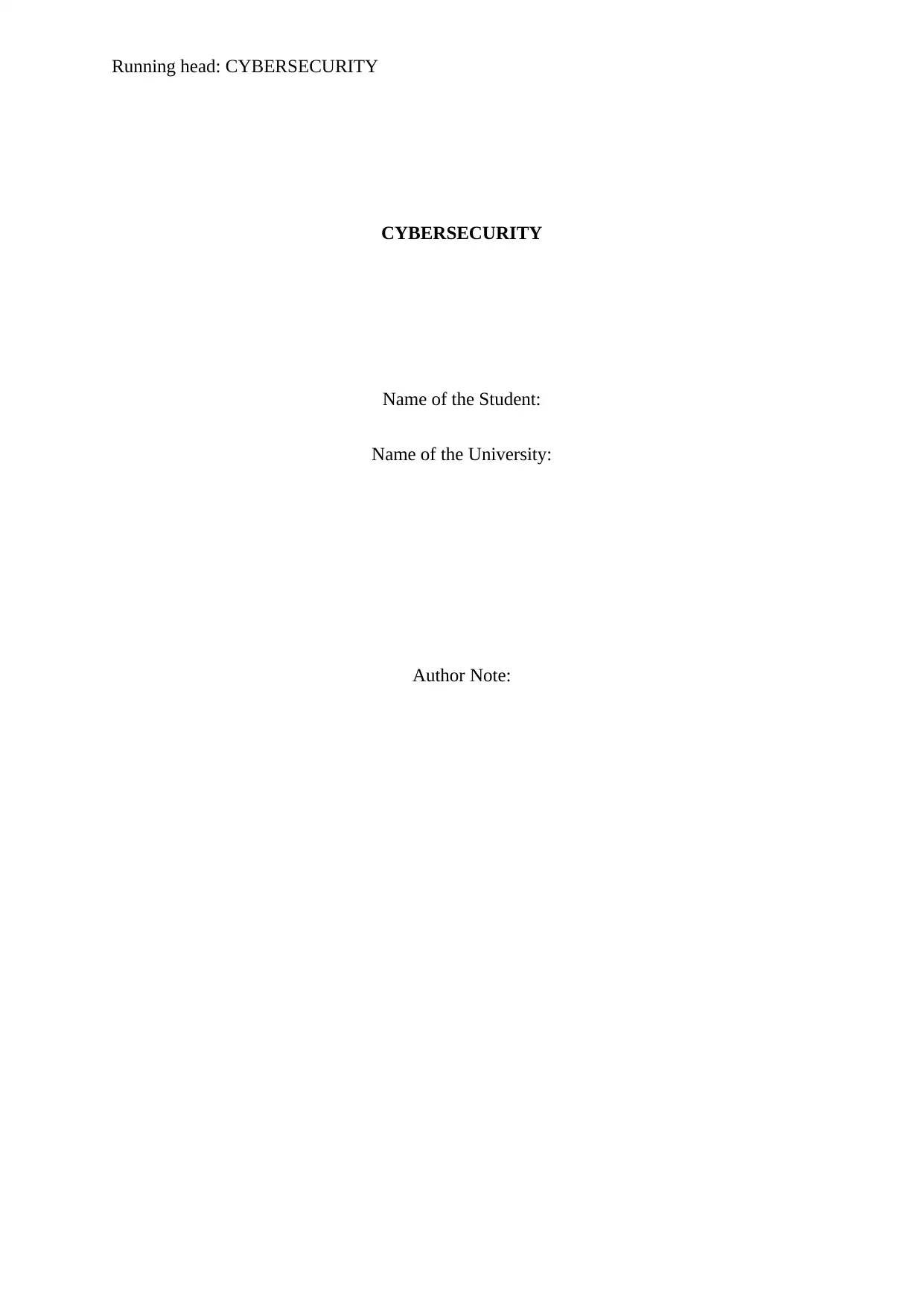
Running head: CYBERSECURITY
CYBERSECURITY
Name of the Student:
Name of the University:
Author Note:
CYBERSECURITY
Name of the Student:
Name of the University:
Author Note:
Paraphrase This Document
Need a fresh take? Get an instant paraphrase of this document with our AI Paraphraser
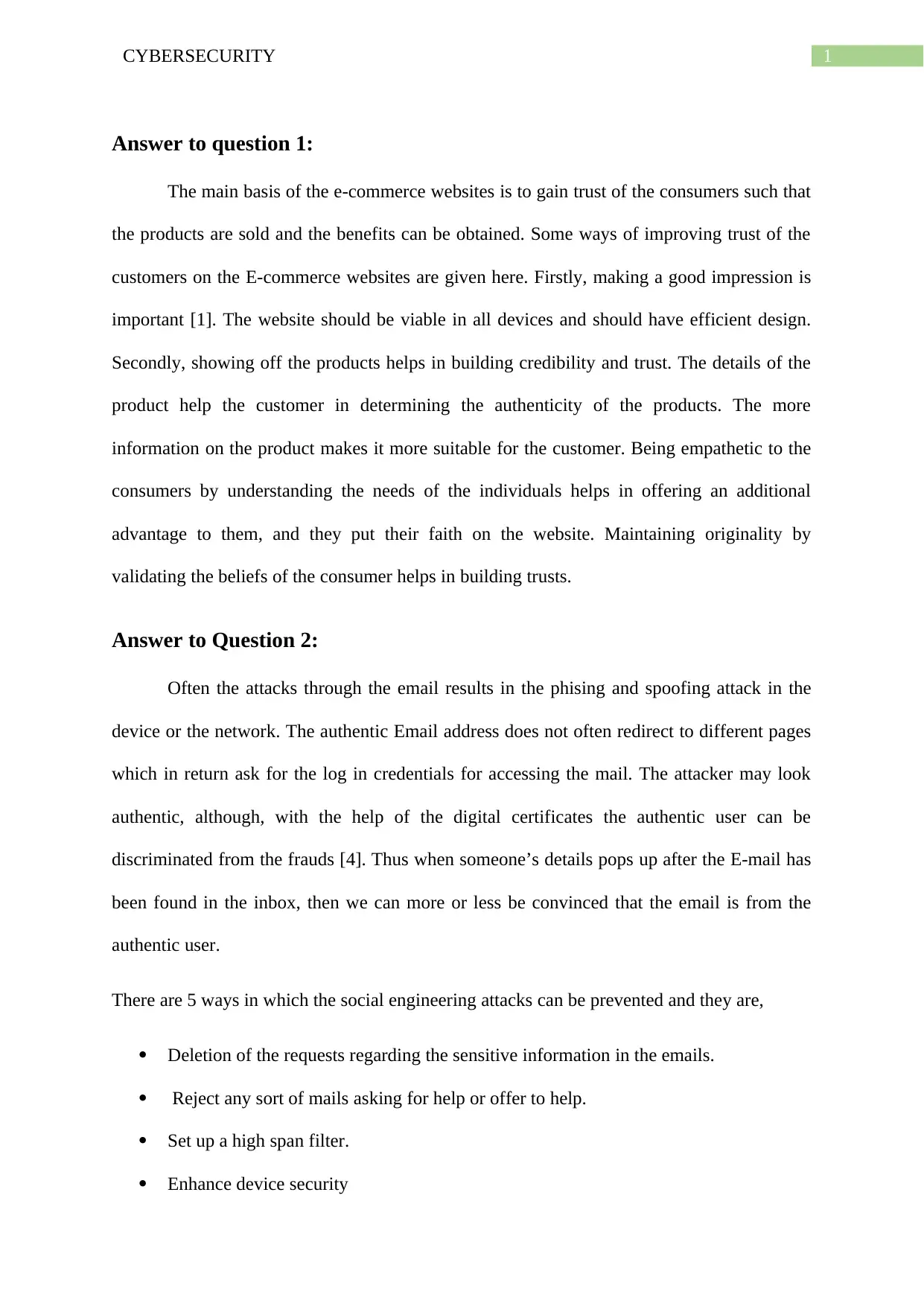
1CYBERSECURITY
Answer to question 1:
The main basis of the e-commerce websites is to gain trust of the consumers such that
the products are sold and the benefits can be obtained. Some ways of improving trust of the
customers on the E-commerce websites are given here. Firstly, making a good impression is
important [1]. The website should be viable in all devices and should have efficient design.
Secondly, showing off the products helps in building credibility and trust. The details of the
product help the customer in determining the authenticity of the products. The more
information on the product makes it more suitable for the customer. Being empathetic to the
consumers by understanding the needs of the individuals helps in offering an additional
advantage to them, and they put their faith on the website. Maintaining originality by
validating the beliefs of the consumer helps in building trusts.
Answer to Question 2:
Often the attacks through the email results in the phising and spoofing attack in the
device or the network. The authentic Email address does not often redirect to different pages
which in return ask for the log in credentials for accessing the mail. The attacker may look
authentic, although, with the help of the digital certificates the authentic user can be
discriminated from the frauds [4]. Thus when someone’s details pops up after the E-mail has
been found in the inbox, then we can more or less be convinced that the email is from the
authentic user.
There are 5 ways in which the social engineering attacks can be prevented and they are,
Deletion of the requests regarding the sensitive information in the emails.
Reject any sort of mails asking for help or offer to help.
Set up a high span filter.
Enhance device security
Answer to question 1:
The main basis of the e-commerce websites is to gain trust of the consumers such that
the products are sold and the benefits can be obtained. Some ways of improving trust of the
customers on the E-commerce websites are given here. Firstly, making a good impression is
important [1]. The website should be viable in all devices and should have efficient design.
Secondly, showing off the products helps in building credibility and trust. The details of the
product help the customer in determining the authenticity of the products. The more
information on the product makes it more suitable for the customer. Being empathetic to the
consumers by understanding the needs of the individuals helps in offering an additional
advantage to them, and they put their faith on the website. Maintaining originality by
validating the beliefs of the consumer helps in building trusts.
Answer to Question 2:
Often the attacks through the email results in the phising and spoofing attack in the
device or the network. The authentic Email address does not often redirect to different pages
which in return ask for the log in credentials for accessing the mail. The attacker may look
authentic, although, with the help of the digital certificates the authentic user can be
discriminated from the frauds [4]. Thus when someone’s details pops up after the E-mail has
been found in the inbox, then we can more or less be convinced that the email is from the
authentic user.
There are 5 ways in which the social engineering attacks can be prevented and they are,
Deletion of the requests regarding the sensitive information in the emails.
Reject any sort of mails asking for help or offer to help.
Set up a high span filter.
Enhance device security
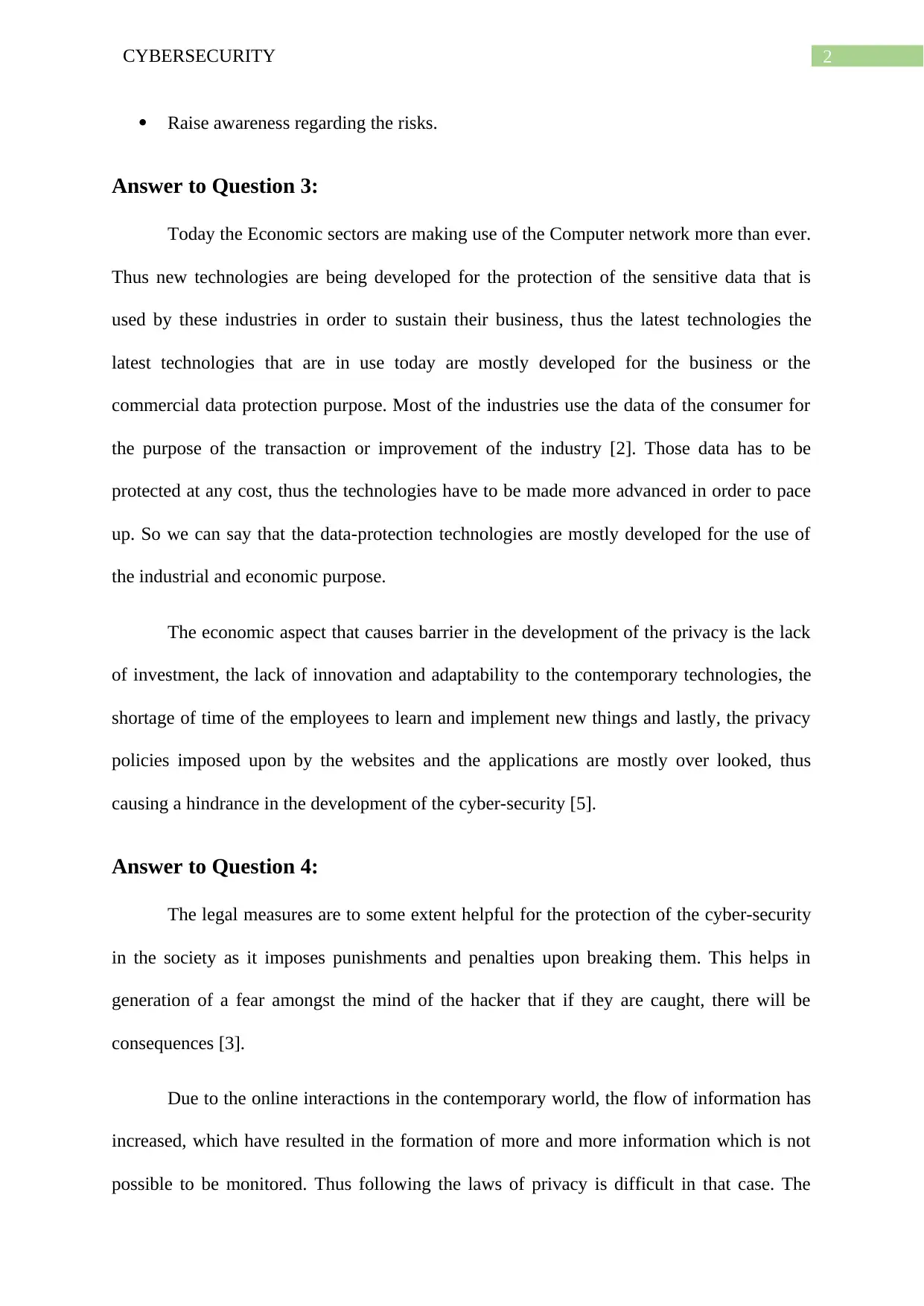
2CYBERSECURITY
Raise awareness regarding the risks.
Answer to Question 3:
Today the Economic sectors are making use of the Computer network more than ever.
Thus new technologies are being developed for the protection of the sensitive data that is
used by these industries in order to sustain their business, thus the latest technologies the
latest technologies that are in use today are mostly developed for the business or the
commercial data protection purpose. Most of the industries use the data of the consumer for
the purpose of the transaction or improvement of the industry [2]. Those data has to be
protected at any cost, thus the technologies have to be made more advanced in order to pace
up. So we can say that the data-protection technologies are mostly developed for the use of
the industrial and economic purpose.
The economic aspect that causes barrier in the development of the privacy is the lack
of investment, the lack of innovation and adaptability to the contemporary technologies, the
shortage of time of the employees to learn and implement new things and lastly, the privacy
policies imposed upon by the websites and the applications are mostly over looked, thus
causing a hindrance in the development of the cyber-security [5].
Answer to Question 4:
The legal measures are to some extent helpful for the protection of the cyber-security
in the society as it imposes punishments and penalties upon breaking them. This helps in
generation of a fear amongst the mind of the hacker that if they are caught, there will be
consequences [3].
Due to the online interactions in the contemporary world, the flow of information has
increased, which have resulted in the formation of more and more information which is not
possible to be monitored. Thus following the laws of privacy is difficult in that case. The
Raise awareness regarding the risks.
Answer to Question 3:
Today the Economic sectors are making use of the Computer network more than ever.
Thus new technologies are being developed for the protection of the sensitive data that is
used by these industries in order to sustain their business, thus the latest technologies the
latest technologies that are in use today are mostly developed for the business or the
commercial data protection purpose. Most of the industries use the data of the consumer for
the purpose of the transaction or improvement of the industry [2]. Those data has to be
protected at any cost, thus the technologies have to be made more advanced in order to pace
up. So we can say that the data-protection technologies are mostly developed for the use of
the industrial and economic purpose.
The economic aspect that causes barrier in the development of the privacy is the lack
of investment, the lack of innovation and adaptability to the contemporary technologies, the
shortage of time of the employees to learn and implement new things and lastly, the privacy
policies imposed upon by the websites and the applications are mostly over looked, thus
causing a hindrance in the development of the cyber-security [5].
Answer to Question 4:
The legal measures are to some extent helpful for the protection of the cyber-security
in the society as it imposes punishments and penalties upon breaking them. This helps in
generation of a fear amongst the mind of the hacker that if they are caught, there will be
consequences [3].
Due to the online interactions in the contemporary world, the flow of information has
increased, which have resulted in the formation of more and more information which is not
possible to be monitored. Thus following the laws of privacy is difficult in that case. The
⊘ This is a preview!⊘
Do you want full access?
Subscribe today to unlock all pages.

Trusted by 1+ million students worldwide
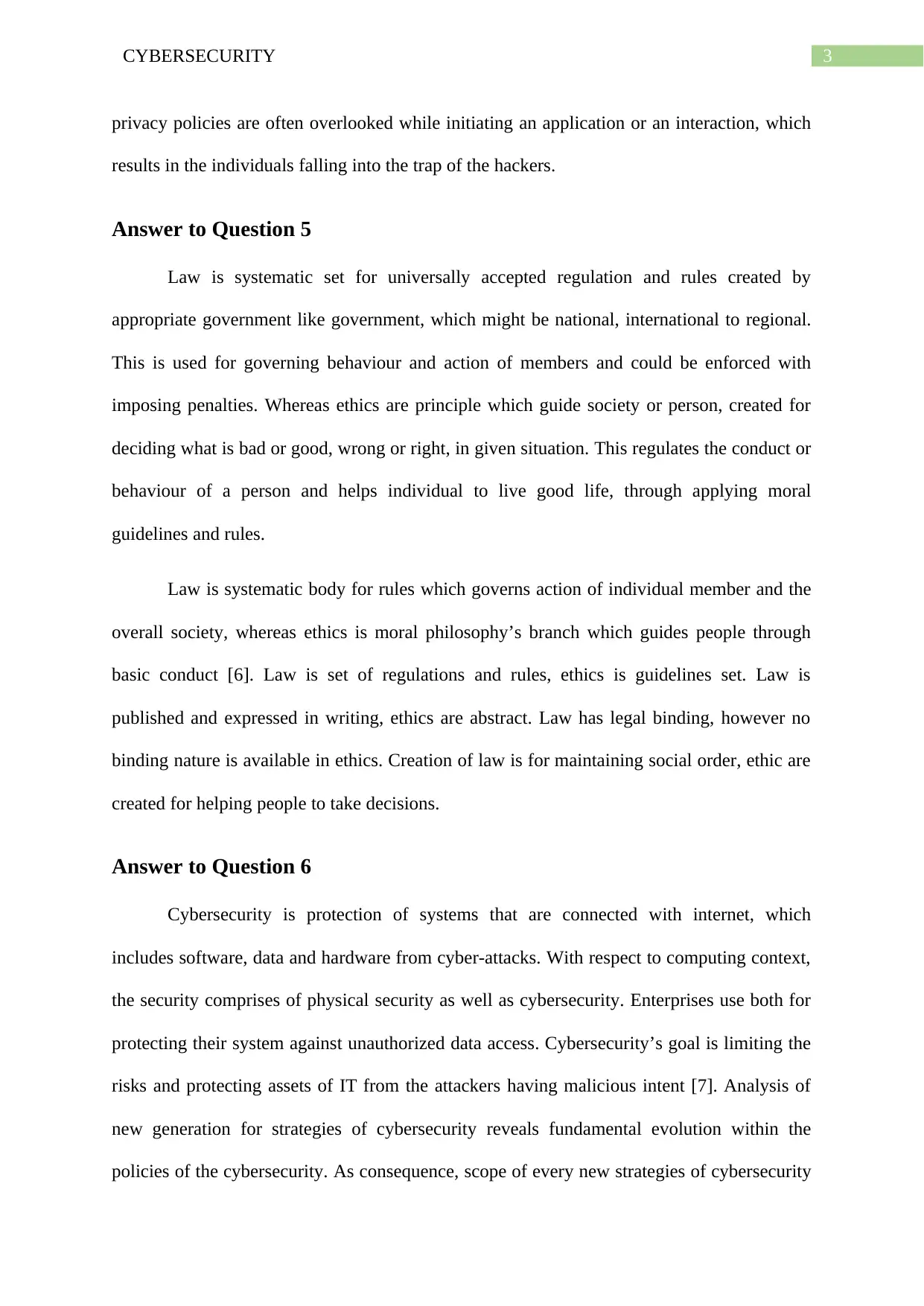
3CYBERSECURITY
privacy policies are often overlooked while initiating an application or an interaction, which
results in the individuals falling into the trap of the hackers.
Answer to Question 5
Law is systematic set for universally accepted regulation and rules created by
appropriate government like government, which might be national, international to regional.
This is used for governing behaviour and action of members and could be enforced with
imposing penalties. Whereas ethics are principle which guide society or person, created for
deciding what is bad or good, wrong or right, in given situation. This regulates the conduct or
behaviour of a person and helps individual to live good life, through applying moral
guidelines and rules.
Law is systematic body for rules which governs action of individual member and the
overall society, whereas ethics is moral philosophy’s branch which guides people through
basic conduct [6]. Law is set of regulations and rules, ethics is guidelines set. Law is
published and expressed in writing, ethics are abstract. Law has legal binding, however no
binding nature is available in ethics. Creation of law is for maintaining social order, ethic are
created for helping people to take decisions.
Answer to Question 6
Cybersecurity is protection of systems that are connected with internet, which
includes software, data and hardware from cyber-attacks. With respect to computing context,
the security comprises of physical security as well as cybersecurity. Enterprises use both for
protecting their system against unauthorized data access. Cybersecurity’s goal is limiting the
risks and protecting assets of IT from the attackers having malicious intent [7]. Analysis of
new generation for strategies of cybersecurity reveals fundamental evolution within the
policies of the cybersecurity. As consequence, scope of every new strategies of cybersecurity
privacy policies are often overlooked while initiating an application or an interaction, which
results in the individuals falling into the trap of the hackers.
Answer to Question 5
Law is systematic set for universally accepted regulation and rules created by
appropriate government like government, which might be national, international to regional.
This is used for governing behaviour and action of members and could be enforced with
imposing penalties. Whereas ethics are principle which guide society or person, created for
deciding what is bad or good, wrong or right, in given situation. This regulates the conduct or
behaviour of a person and helps individual to live good life, through applying moral
guidelines and rules.
Law is systematic body for rules which governs action of individual member and the
overall society, whereas ethics is moral philosophy’s branch which guides people through
basic conduct [6]. Law is set of regulations and rules, ethics is guidelines set. Law is
published and expressed in writing, ethics are abstract. Law has legal binding, however no
binding nature is available in ethics. Creation of law is for maintaining social order, ethic are
created for helping people to take decisions.
Answer to Question 6
Cybersecurity is protection of systems that are connected with internet, which
includes software, data and hardware from cyber-attacks. With respect to computing context,
the security comprises of physical security as well as cybersecurity. Enterprises use both for
protecting their system against unauthorized data access. Cybersecurity’s goal is limiting the
risks and protecting assets of IT from the attackers having malicious intent [7]. Analysis of
new generation for strategies of cybersecurity reveals fundamental evolution within the
policies of the cybersecurity. As consequence, scope of every new strategies of cybersecurity
Paraphrase This Document
Need a fresh take? Get an instant paraphrase of this document with our AI Paraphraser
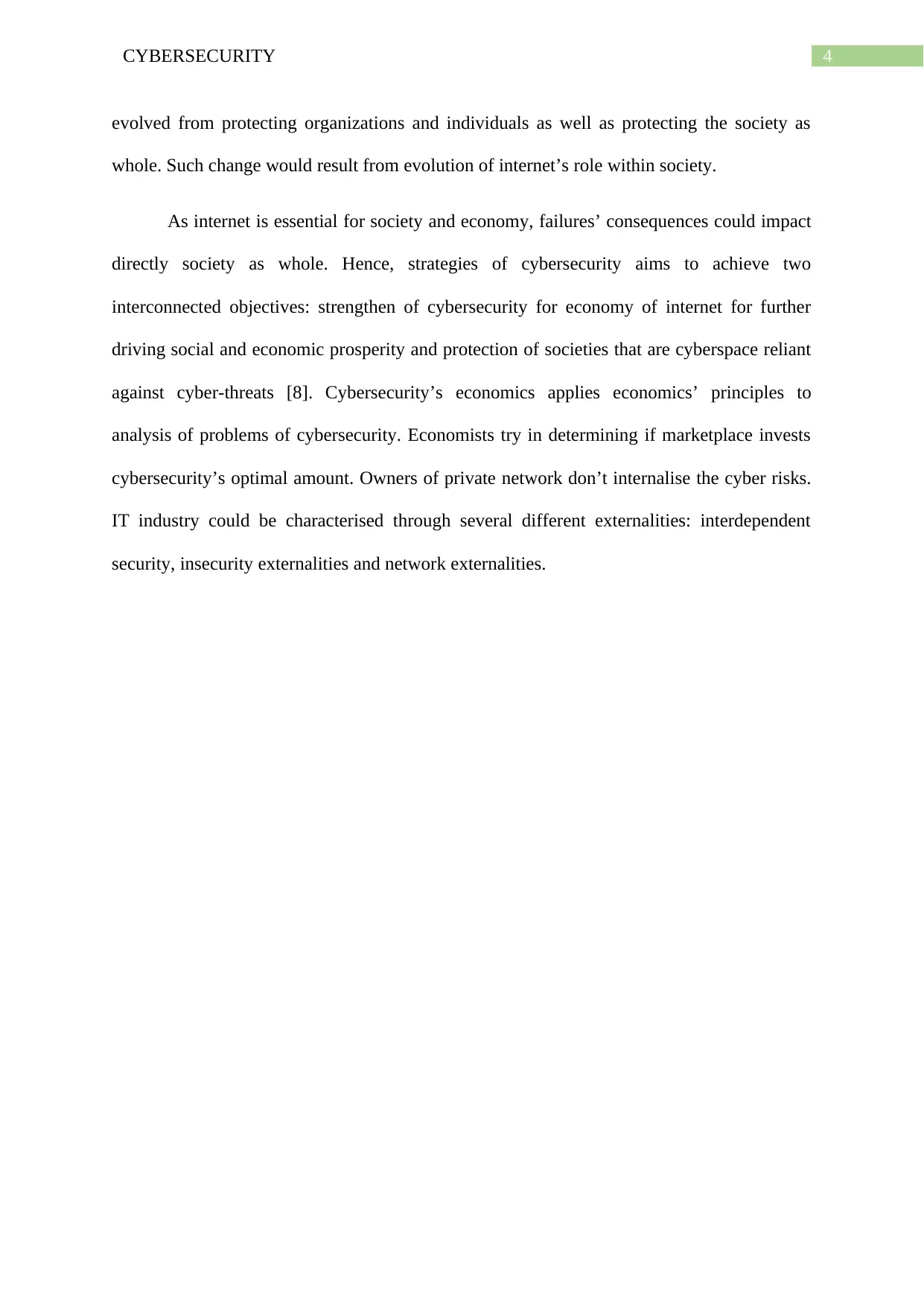
4CYBERSECURITY
evolved from protecting organizations and individuals as well as protecting the society as
whole. Such change would result from evolution of internet’s role within society.
As internet is essential for society and economy, failures’ consequences could impact
directly society as whole. Hence, strategies of cybersecurity aims to achieve two
interconnected objectives: strengthen of cybersecurity for economy of internet for further
driving social and economic prosperity and protection of societies that are cyberspace reliant
against cyber-threats [8]. Cybersecurity’s economics applies economics’ principles to
analysis of problems of cybersecurity. Economists try in determining if marketplace invests
cybersecurity’s optimal amount. Owners of private network don’t internalise the cyber risks.
IT industry could be characterised through several different externalities: interdependent
security, insecurity externalities and network externalities.
evolved from protecting organizations and individuals as well as protecting the society as
whole. Such change would result from evolution of internet’s role within society.
As internet is essential for society and economy, failures’ consequences could impact
directly society as whole. Hence, strategies of cybersecurity aims to achieve two
interconnected objectives: strengthen of cybersecurity for economy of internet for further
driving social and economic prosperity and protection of societies that are cyberspace reliant
against cyber-threats [8]. Cybersecurity’s economics applies economics’ principles to
analysis of problems of cybersecurity. Economists try in determining if marketplace invests
cybersecurity’s optimal amount. Owners of private network don’t internalise the cyber risks.
IT industry could be characterised through several different externalities: interdependent
security, insecurity externalities and network externalities.
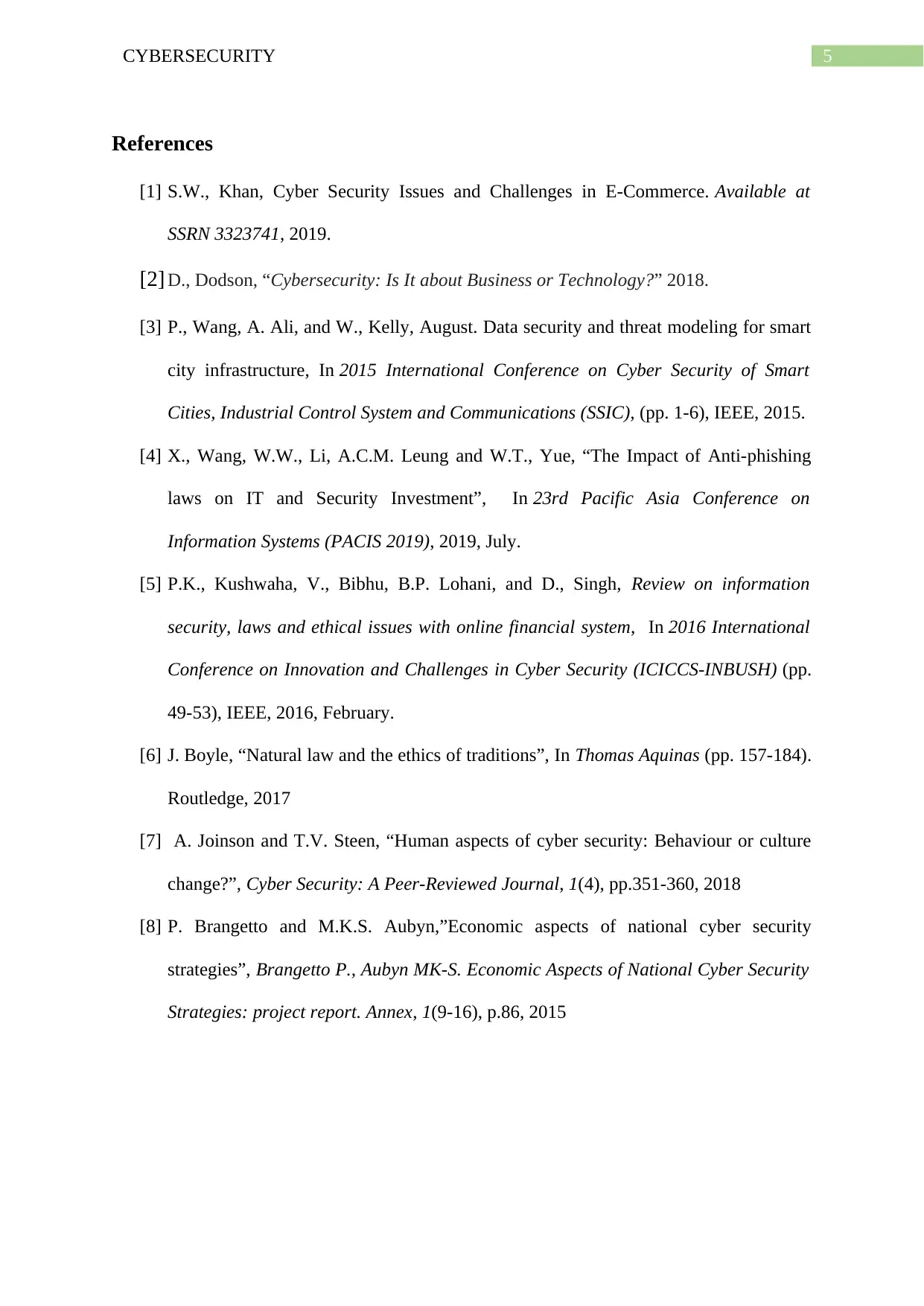
5CYBERSECURITY
References
[1] S.W., Khan, Cyber Security Issues and Challenges in E-Commerce. Available at
SSRN 3323741, 2019.
[2] D., Dodson, “Cybersecurity: Is It about Business or Technology?” 2018.
[3] P., Wang, A. Ali, and W., Kelly, August. Data security and threat modeling for smart
city infrastructure, In 2015 International Conference on Cyber Security of Smart
Cities, Industrial Control System and Communications (SSIC), (pp. 1-6), IEEE, 2015.
[4] X., Wang, W.W., Li, A.C.M. Leung and W.T., Yue, “The Impact of Anti-phishing
laws on IT and Security Investment”, In 23rd Pacific Asia Conference on
Information Systems (PACIS 2019), 2019, July.
[5] P.K., Kushwaha, V., Bibhu, B.P. Lohani, and D., Singh, Review on information
security, laws and ethical issues with online financial system, In 2016 International
Conference on Innovation and Challenges in Cyber Security (ICICCS-INBUSH) (pp.
49-53), IEEE, 2016, February.
[6] J. Boyle, “Natural law and the ethics of traditions”, In Thomas Aquinas (pp. 157-184).
Routledge, 2017
[7] A. Joinson and T.V. Steen, “Human aspects of cyber security: Behaviour or culture
change?”, Cyber Security: A Peer-Reviewed Journal, 1(4), pp.351-360, 2018
[8] P. Brangetto and M.K.S. Aubyn,”Economic aspects of national cyber security
strategies”, Brangetto P., Aubyn MK-S. Economic Aspects of National Cyber Security
Strategies: project report. Annex, 1(9-16), p.86, 2015
References
[1] S.W., Khan, Cyber Security Issues and Challenges in E-Commerce. Available at
SSRN 3323741, 2019.
[2] D., Dodson, “Cybersecurity: Is It about Business or Technology?” 2018.
[3] P., Wang, A. Ali, and W., Kelly, August. Data security and threat modeling for smart
city infrastructure, In 2015 International Conference on Cyber Security of Smart
Cities, Industrial Control System and Communications (SSIC), (pp. 1-6), IEEE, 2015.
[4] X., Wang, W.W., Li, A.C.M. Leung and W.T., Yue, “The Impact of Anti-phishing
laws on IT and Security Investment”, In 23rd Pacific Asia Conference on
Information Systems (PACIS 2019), 2019, July.
[5] P.K., Kushwaha, V., Bibhu, B.P. Lohani, and D., Singh, Review on information
security, laws and ethical issues with online financial system, In 2016 International
Conference on Innovation and Challenges in Cyber Security (ICICCS-INBUSH) (pp.
49-53), IEEE, 2016, February.
[6] J. Boyle, “Natural law and the ethics of traditions”, In Thomas Aquinas (pp. 157-184).
Routledge, 2017
[7] A. Joinson and T.V. Steen, “Human aspects of cyber security: Behaviour or culture
change?”, Cyber Security: A Peer-Reviewed Journal, 1(4), pp.351-360, 2018
[8] P. Brangetto and M.K.S. Aubyn,”Economic aspects of national cyber security
strategies”, Brangetto P., Aubyn MK-S. Economic Aspects of National Cyber Security
Strategies: project report. Annex, 1(9-16), p.86, 2015
⊘ This is a preview!⊘
Do you want full access?
Subscribe today to unlock all pages.

Trusted by 1+ million students worldwide
1 out of 6
Related Documents
Your All-in-One AI-Powered Toolkit for Academic Success.
+13062052269
info@desklib.com
Available 24*7 on WhatsApp / Email
![[object Object]](/_next/static/media/star-bottom.7253800d.svg)
Unlock your academic potential
Copyright © 2020–2025 A2Z Services. All Rights Reserved. Developed and managed by ZUCOL.





